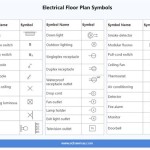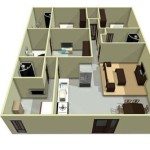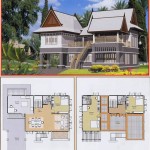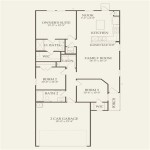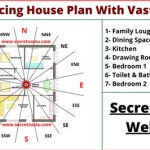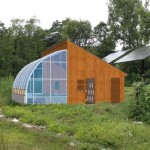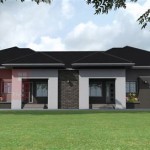Typical American House Floor Plan
The concept of a "typical" American house floor plan is inherently fluid, changing with architectural trends, regional preferences, and evolving lifestyles. However, certain features and layouts consistently appear, offering insights into the priorities and needs of American homeowners. Examining these common elements provides a valuable understanding of residential design in the United States.
One of the most prevalent floor plan types is the ranch style. Characterized by its single-story construction and sprawling layout, the ranch offers ease of access and a connection to the outdoors. Common features include an attached garage, a combined living and dining area, and a kitchen often open to the family room. Bedrooms typically cluster on one side of the house, offering a degree of privacy from the common areas. Ranch houses are adaptable to various lot sizes and are particularly popular in suburban developments.
Two-story homes offer increased living space within a similar footprint compared to ranch houses. These designs often prioritize separating private and public spaces. The main floor typically houses common areas such as the living room, dining room, kitchen, and often a half-bath or powder room. The upper floor is generally reserved for bedrooms and full bathrooms, creating a distinct zone for rest and relaxation. Variations on the two-story layout include the Cape Cod and Colonial styles, which often incorporate architectural details specific to their historical inspirations.
Split-level homes, popularized in the mid-20th century, represent a unique approach to vertical space. These designs stagger floor levels, creating distinct zones connected by short staircases. A typical split-level might feature an entry level leading to a few steps up to the main living area and a few steps down to a family room or recreational space. Bedrooms are often located on the uppermost level, providing a sense of separation from the common areas. This layout efficiently utilizes space and creates visual interest.
The open floor plan has become increasingly prevalent in recent decades. This design emphasizes connectivity between the kitchen, dining area, and living room, creating a single, large space for socializing and family interaction. Open floor plans offer a sense of spaciousness and facilitate natural light flow. While highly desirable for their versatility, considerations for noise control and visual clutter are important design elements within open concept homes.
Modern trends in American house floor plans reflect changing lifestyles and priorities. The inclusion of home offices or dedicated workspaces has become increasingly common, reflecting the rise of remote work. Multi-generational living arrangements are also driving design changes, with some homes incorporating in-law suites or accessory dwelling units to accommodate extended family members. Sustainability considerations are also gaining prominence, influencing choices in building materials and energy-efficient design features.
Regional variations play a significant role in shaping typical floor plans. Homes in warmer climates often feature outdoor living spaces, such as covered patios or expansive decks, seamlessly integrating indoor and outdoor living. Homes in colder climates may prioritize features like mudrooms or dedicated entryways to manage snow and winter gear. Local building codes and regulations also influence design choices, impacting aspects such as roof pitch, window placement, and foundation design.
Beyond the basic layout, features within the rooms themselves contribute to the overall functionality of a floor plan. Master suites, often including walk-in closets and en-suite bathrooms, have become a standard feature in many new homes. Kitchen islands have gained popularity as central hubs for meal preparation and informal dining. Laundry rooms, once relegated to basements or utility spaces, are increasingly integrated into the main living areas for greater convenience.
The evolution of American house floor plans continues to reflect societal shifts and technological advancements. Smart home technology is increasingly integrated into new constructions, offering homeowners greater control over lighting, security, and energy consumption. Universal design principles, which prioritize accessibility and adaptability, are also gaining traction, creating homes that can accommodate changing needs over time. These ongoing developments ensure that the "typical" American house floor plan remains a dynamic and evolving concept.
Examining popular house plan websites and consulting with architects and builders can provide valuable insights into current trends and regional preferences. Understanding the key elements and variations within typical American house floor plans empowers individuals to make informed decisions when designing, purchasing, or renovating a home.

Level 1 House Plans American Floor Plan Design

Distinctive House Plans Colonial Early American Traditional Style Plan 4 Beds 2 Floor Design

House Plan 034 00278 Country 1 339 Square Feet 3 Bedrooms Bathroom Bungalow Plans Floor

New American House Plan With 3080 Square Feet And 4 Bedrooms From Dream Home Source C Plans One Story Floor

House Plan 034 01089 Traditional 1 531 Square Feet 3 Bedrooms 2 Bathrooms Plans New Drummond

37 American Best House Plans Ideas Floor How To Plan

New American Best House Plans Floor And Photos

House Plan 034 00198 Country 1 201 Square Feet 3 Bedrooms Bathroom Plans Drummond Bungalow Floor

Traditional Style House Plan 3 Beds 2 Baths 2149 Sq Ft 40 474 Eplans Com

Classic American Home Plan 62100v Architectural Designs House Plans

